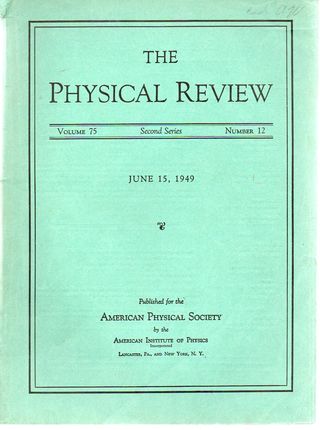 Bohm, David and E.P. Gross. "Theory of Plasma Osciallations A, Origin of Medium-Like Behavior." (pp 1851-1863). "Theory of Plasma Oscialltion B, Excitations and Damping of Oscillations". (pp 1864-1877). Both papers in the same issue of The Physical Review, volume 75/number 12, 15 June 1949. Original printed wrappers. Very good condition. $195
Bohm, David and E.P. Gross. "Theory of Plasma Osciallations A, Origin of Medium-Like Behavior." (pp 1851-1863). "Theory of Plasma Oscialltion B, Excitations and Damping of Oscillations". (pp 1864-1877). Both papers in the same issue of The Physical Review, volume 75/number 12, 15 June 1949. Original printed wrappers. Very good condition. $195
From the Niels Bohr Library, "Interview with Dr. David Bohm, by Lillian Hoddeson, at the home of the Bohms, Edgware, London, May 8, 1988".
Hoddeson:
Returning to Bohm and Gross, the first paper develops a theory of an unbounded plasma, and the mechanism for such oscillation. The second one includes the collisions and instabilities produced by part of the sharply defined velocity, and excitation and the damping of oscillations. The last one is on boundary effects. This then laid the basis for the work you then did with Pines.
Bohm:
Yes, it helped there. It helped lay a basis. It wasn’t a complete basis, but it helped clear up quite a few questions that had to be cleared up in order to do this other work about what we meant by a plasma, and so on, and how it all worked.
From the PROLA website:
"Received 13 January 1949; published in the issue dated June 1949
A theory of electron oscillations of an unbounded plasma of uniform ion density is developed, taking into account the effects of random thermal motions, but neglecting collisions.
The first problem considered is that of finding the frequencies at which a plasma can undergo organized steady-state oscillations of small enough amplitude so that a linear approximation applies. It is found that long wave-length oscillations of plasmas with a Maxwell distribution of electron velocities are characterized by the steady-state dispersion relation ω2=ωP2+(3κT/m)(2π/λ)2. Here ωP is the plasma frequency, T the absolute temperature of the electron gas, λ the wave-length, and ω the angular frequency of oscillation. It is also shown that organized oscillations of wave-lengths smaller than the Debye length for the electron gas are not possible.
The theory is then extended to describe the processes by which oscillations are set up. It is found that, for a given wave-length, a plasma can oscillate with arbitrary frequency, but that those frequencies not given by the steady-state dispersion relation describe motions in which, after some time, there is no contribution to macroscopic averages. These additional frequencies lead asymptotically only to microscopic fluctuations of the charge density about the organized oscillation of the plasma. In this way, one can describe the manner in which the system develops organized behavior.
The treatment is then applied to large steady-state oscillations for which the equations are non-linear. One obtains solutions in which particles close to the wave velocity are trapped in the trough of the potential, oscillating back and forth about a mean velocity equal to that of the wave. One can also obtain non-linear traveling pulse solutions in which a group of particles, moving as a pulse, creates a reaction on the surrounding charge, which traps the particles and holds them together."




Comments